The American Institute of Architects (AIA) Committee on Architecture for Education (CAE) has selected 12 projects for this year’s CAE Education Facility Design Awards. The program honors educational facilities that the jury believes should serve as an example of a superb place in which to learn, furthering the client's mission, goals, and educational program while demonstrating excellence in architectural design.
The 12 winners are listed below.
Henderson-Hopkins School; Baltimore
Rogers Partners
Associate Architect: Architects+Urban Designers
Award of Excellence
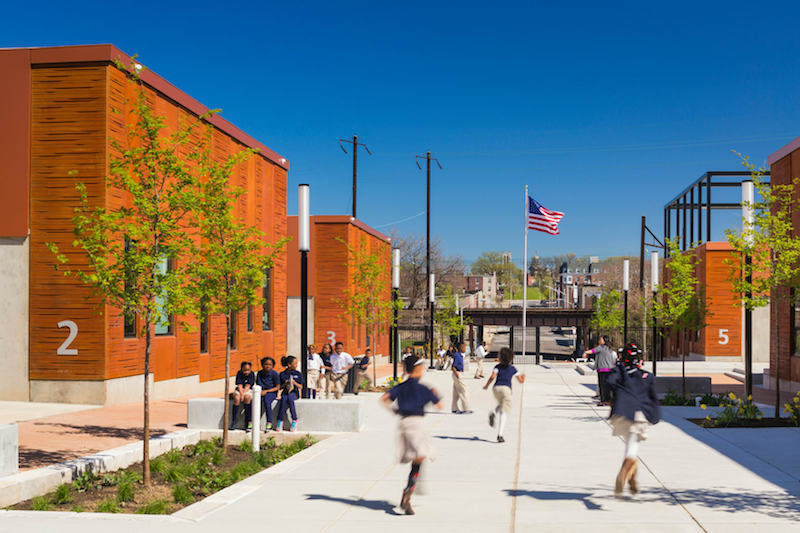
The Henderson-Hopkins School is the first new Baltimore public school in nearly 30 years. A 125,000-square-foot K-8 partnership school and early childhood center run by Johns Hopkins University, Henderson-Hopkins is a progressive learning environment for children and a laboratory for the next generation of educators.
The school is a cluster of “containers for learning” inspired by East Baltimore’s row houses, stoops, and social civic spaces. Through its intentionally porous, safe, urban plan, and the craftsmanship of light, materiality, and performance, its design respects history and supports the future of education and of its neighborhood.
Mundo Verde Bilingual Public Charter School; Washington, DC
Studio Twenty Seven Architecture
Award of Excellence
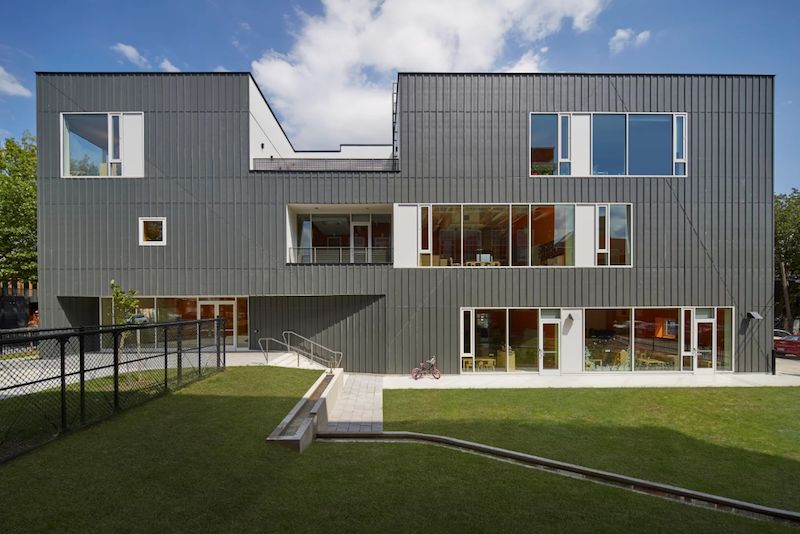
Mundo Verde is a bilingual, sustainability-focused public charter school located in the District of Columbia. The school’s curriculum is based on expeditionary learning, where students learn through the critical exploration of complex issues.
Awarded a shuttered 1920s-era school building and site by the District in 2013, Mundo Verde had a direct question for the design team: “How can this redevelopment and addition project teach our students to be global stewards?” From the renovation of the existing building to the precise detailing and material efficiency of the Pre-K annex, the entire campus is designed to foster learning through environmental living.
Regional Plant 2 Teaching Facility, Wake Technical Community College; Raleigh, N.C.
Clark Nexsen
Award of Excellence
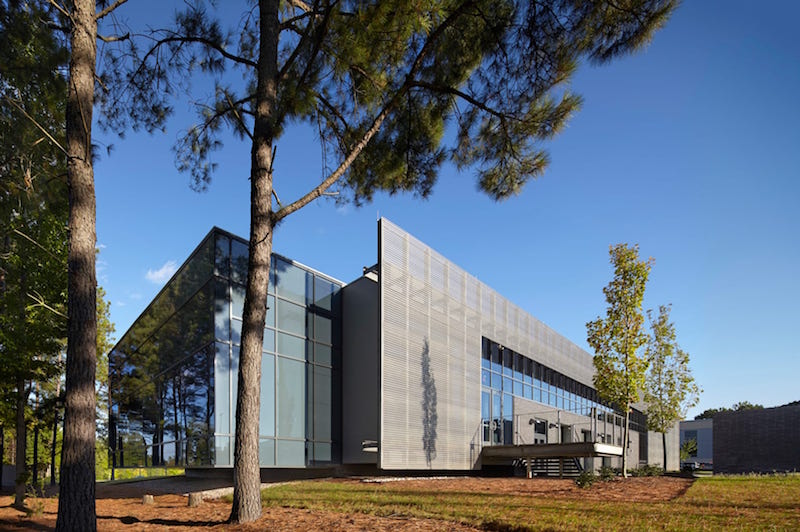
Located at the entrance of Wake Tech Community College on a wooded site, the Regional Plant Teaching Facility creates a gateway to the campus and symbolizes the merging of technology, education and sustainability.
Although the building’s program is composed of spaces to house heating and cooling equipment, it also serves as an educational facility for teaching students and the public about energy-efficient building systems. A simple rectilinear glass and steel box with a perforated metal screen layer houses, screens and displays the technology and creates a unique educational space for the college.
Regional Plant
Richard Ivey Building, Richard Ivey School of Business, Western University; London, Ontario, Canada
Hariri Pontarini Architects
Award of Excellence

The vision for the Richard Ivey Building was creation of a vibrant, unified campus that would attract the best students and faculty, express the school’s global identity, and celebrate Western University itself.
Located on the western edge of the university’s campus at an active corner, the Richard Ivey Building is a beacon, a signifier of the school’s flagship status. Echoing the architecture of Western University's campus and the adjacent Brescia College, the solid masonry on the exterior conveys the traditional materiality of the University’s Gothic architecture, making it a modern building rooted in tradition.
Seton Hill Arts Center, Seton Hill University; Greensburg, Pa.
designLAB architects
Associate Architect: BSHM Architects
Award of Excellence

Seton Hill University’s new performing and visual arts facility is an interdisciplinary arts center that connects the local community with members of the university. Channeling the Pittsburgh area’s industrial heritage, the steel frame and metal-clad building was conceived as a “Factory for the Arts.” The project features an outdoor Arts Yard where the making of 3D arts is visible from the commercial Main Street in its host city of Greensburg, Pennsylvania.
The four-level facility features a full complement of studio spaces for traditional disciplines like painting, drawing, printmaking, sculpture, dance and theater, along with tech-heavy digital and graphic arts. The new building is an economic catalyst for the city’s cultural district, drawing local artists, gallery observers, and performing arts attendees to support and critique student work.
Vol Walker Hall Renovation & The Steven L. Anderson Design Center, University of Arkansas; Fayetteville, Ark.
Marlon Blackwell Architects
Associate Architect: Polk Stanley Wilcox Architects
Award of Excellence
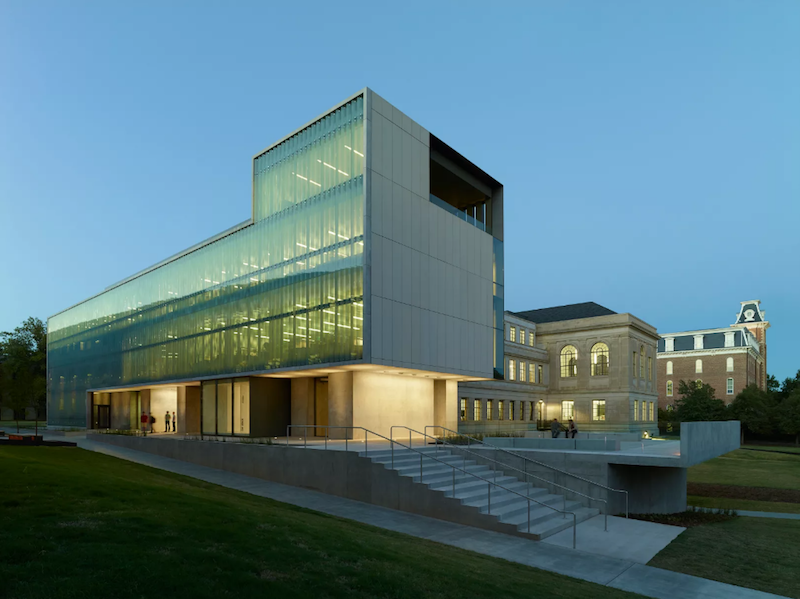
Vol Walker Hall and the addition of the Steven L. Anderson Design Center for the Fay Jones School of Architecture and Design at the University of Arkansas is a complex but resolute hybrid of a historic restoration and a contemporary insertion and expansion.
Post-tensioned concrete and Indiana limestone honor the weight and substance of the historic, while the west-facing fritted glass brise-soleil and steel curtainwall create a contemporary figure. The overall design is a didactic model, establishing a tangible discourse between past and present, while providing state of the art facilities for 21st century architectural and design education.
Dwight-Englewood School Hajjar STEM Center; Englewood, N.J.
Gensler
Award of Merit

The new 28,000-square-foot building at the Dwight-Englewood School, an independent day school for PK-12, is the realization of a multi-year exploration and visioning process. It is also the embodiment of the school’s mission and growing STEM (science, technology, engineering, math) curriculum.
The technically innovative, highly sustainable, programmatically energized, and contextually sensitive solution equals an expanded campus that seeks to unify Dwight-Englewood's community of faculty, students, and administration and create a center of excellence around this ever-important pedagogy.
Fayetteville High School Addition and Renovation; Fayetteville, Ark.
Hight Jackson Associates
Associate Architect: DLR Group and Marlon Blackwell Architects
Award of Merit

To maintain its competitive advantage in academics, Fayetteville Public Schools tasked the design team to strategically restructure its high school education program into a small learning community (SLC) model. At more than 500,000 square feet, this project is the largest civic project in Fayetteville over the past 50 years. It constitutes an addition and a massive modernization of aged buildings through a 36-month phased approach, allowing for continuous operation of the school during construction.
Fayetteville High School features greatly simplified circulation and improved security around a public entry plaza and a pedestrian green street that mediates between the first and second phase and the 85-foot change in topography across the site. SLCs are designed with core learning studios that feature discovery, project-based learning, digital and applied learning labs to foster collaboration. Distributed administration, resource centers and dining allow students to spend a majority of their day within their SLC. The addition features abundant glass and overlooks a new landscaped street that creates a collegiate campus feel reflective of the school's ties to the University of Arkansas.
GateWay Community College Integrated Education Building; Phoenix
SmithGroupJJR
Award of Merit
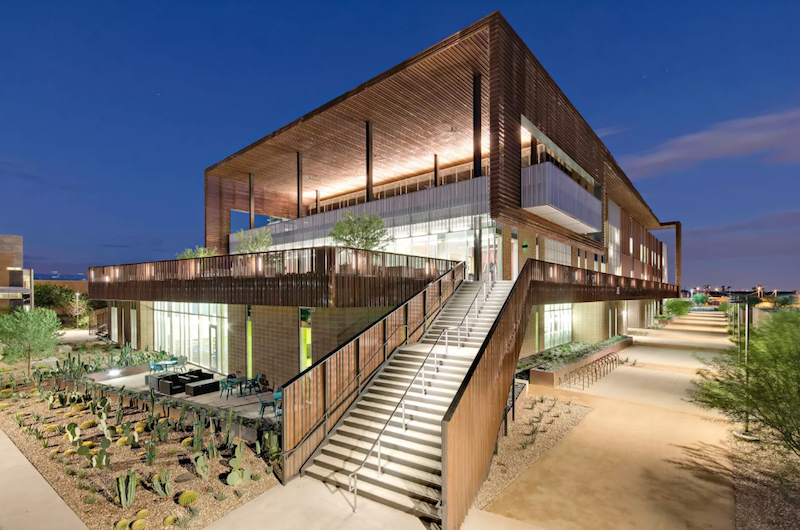
GateWay Community College, located centrally in the metropolitan Phoenix area, has created a new all-in-one 122,000-gross-square-foot facility for their urban campus. The Integrated Education Building (IEB) is centrally located on campus and meshes an entire new campus of functions into a single three-story structure.
The IEB provides a new student services center, learning center and community library, instructional labs, classrooms, faculty offices and a large community-oriented 200-seat multi-purpose room. The project both transforms the campus and provides metamorphic momentum for a historically blighted and under-valued part of the city.
Harvard Business School, Tata Hall; Boston
William Rawn Associates, Architects, Inc.
Award of Merit

Sited on the banks of the Charles River, Tata Hall at Harvard Business School creates a porous edge to the campus and a new sense of openness between the school and the city of Boston. Dedicated to the Executive Education program, the building groups students into clusters of eight-person suites, each with a common space for work, collaboration and presentations.
Indian Springs School; Birmingham, Ala.
Lake|Flato Architects
Associate Architect: Architecture Works
Award of Merit

Founded in 1952 on the motto, “Learning Through Living,” Indian Springs School is a place of exceptional people and purpose. The 350-acre boarding and day school campus, originally planned by the Olmstead Brothers, was functional and serviceable but aging facilities were inhibiting the growth of educational programs and opportunities.
This first phase of a comprehensive master plan includes new academic and administrative buildings and complementary landscapes that create a memorable, meaningful place. The new academic heart of the campus recalls its original vision with a contemporary overlay of teaching methodology, technology, aesthetics and performance that make a unique learning environment—Springsian in every way.
Kennedy Child Study Center; East Harlem, N.Y.
Pell Overton Architects
Award of Merit

Last summer, the 165-family Kennedy Child Study Center relocated to a new home in East Harlem, occupying two floors of a previously un-renovated 1930’s warehouse building. The adaptive reuse of the 25,000-square-foot space presented a number of difficult challenges, including an unusually low ceiling and absence of any natural light.
Consequently, the design of the 16-classroom facility developed around the need to radically transform the existing warehouse into a varied space for learning and engagement, creating a sense of both openness to the surrounding community and continuity between the neighborhood and the individual classroom environments.
The jury for the 2016 Educational Facility Design Awards includes: Karina Ruiz, AIA (Chair), DOWA-IBI Group Architects; Christina Alvarez, Delaware Design Lab HS; Helena L. Jubany, FAIA, NAC/Architecture; Bruce Lindsey, AIA, Washington University in St. Louis; Zachary Neubauer, University of Portland and Steve Ziger, AIA, Ziger/Snead Architects.
See the full release here.
Related Stories
Standards | Jun 26, 2023
New Wi-Fi standard boosts indoor navigation, tracking accuracy in buildings
The recently released Wi-Fi standard, IEEE 802.11az enables more refined and accurate indoor location capabilities. As technology manufacturers incorporate the new standard in various devices, it will enable buildings, including malls, arenas, and stadiums, to provide new wayfinding and tracking features.
Engineers | Jun 14, 2023
The high cost of low maintenance
Walter P Moore’s Javier Balma, PhD, PE, SE, and Webb Wright, PE, identify the primary causes of engineering failures, define proactive versus reactive maintenance, recognize the reasons for deferred maintenance, and identify the financial and safety risks related to deferred maintenance.
University Buildings | Jun 14, 2023
Calif. State University’s new ‘library-plus’ building bridges upper and lower campuses
A three-story “library-plus” building at California State University, East Bay (CSUEB) that ties together the upper and lower campuses was recently completed. The 100,977-sf facility, known as the Collaborative Opportunities for Research & Engagement (“CORE”) Building, is one of the busiest libraries in the CSU system. The previous library served 1.2 million visitors annually.
Higher Education | Jun 14, 2023
Designing higher education facilities without knowing the end users
A team of architects with Page offers five important factors to consider when designing spaces for multiple—and potentially changing—stakeholders.
University Buildings | Jun 9, 2023
Cornell’s new information science building will foster dynamic exchange of ideas and quiet, focused research
Construction recently began on Cornell University’s new 135,000-sf building for the Cornell Ann S. Bowers College of Computing and Information Science (Cornell Bowers CIS). The structure will bring together the departments of Computer Science, Information Science, and Statistics and Data Science for the first time in one complex.
Student Housing | Jun 5, 2023
The power of student engagement: How on-campus student housing can increase enrollment
Studies have confirmed that students are more likely to graduate when they live on campus, particularly when the on-campus experience encourages student learning and engagement, writes Design Collaborative's Nathan Woods, AIA.
K-12 Schools | May 30, 2023
K-12 school sector trends for 2023
Budgeting and political pressures aside, the K-12 school building sector continues to evolve. Security remains a primary objective, as does offering students more varied career options.
K-12 Schools | May 22, 2023
The revival of single-building K-12 schools
Schools that combine grades PK through 12 are suddenly not so uncommon. Education sector experts explain why.
K-12 Schools | May 17, 2023
Designing K-12 schools for students and safety
While bullying, mental health, and other acts of violence are all too common in schools today, designers have shown that smart and subtle preventive steps can make a big difference. Clark Nexsen’s Becky Brady shares how prevention and taking action at the design level can create safe and engaging learning environments.
University Buildings | May 17, 2023
New UC Irvine health sciences building supports aim to become national model for integrative health
The new College of Health Sciences Building and Nursing & Health Sciences Hall at the University of California Irvine supports the institution’s goal of becoming a national model for integrative health. The new 211,660-sf facility houses nursing, medical doctorate, pharmacy, philosophy, and public health programs in a single building.

















